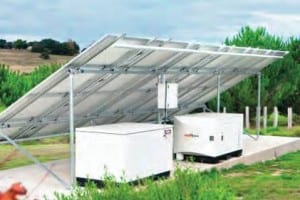By Giles Parkinson on 14 August 2014
Wednesday’s story about the rapidly approaching status of socket parity for solar and battery storage sparked a lot of interest, and a bunch of email requests asking for more information.
That story pointed out that if Brisbane-based Redflow could increase the number of cycles in its zinc-bromine flow batteries, it could be cost competitive with the grid within a few years.
 Here’s some more information from the report from Australian broking house Morgans. The table below is instructive because it includes the estimated capital cost of the storage system, plus the integrated systems manager. It notes that at its current cycles capability of just 1,000, the technology costs $1.29/kWh – effectively pricing it out of the market.
Here’s some more information from the report from Australian broking house Morgans. The table below is instructive because it includes the estimated capital cost of the storage system, plus the integrated systems manager. It notes that at its current cycles capability of just 1,000, the technology costs $1.29/kWh – effectively pricing it out of the market.But that cost is lowered by half if the number of cycles is doubled. If the cycles can be increased to 3,500, and the kWh of storage increased from 8 to 10, then the cost of the technology falls to just 29c/kWh.
That, says Morgans, is very possible. And it means that the technology will be competitive with the grid.
“If Solar currently costs 10-12c (unsubsidised) then Australian energy storage will not be competitive with average grid prices any time soon. However with storage costs of ~30c there could still be a commercial case for peak shifting,” Morgans notes.
Without that increase in cycles, and peak pricing, the short term the economics of using a ZBM in conjunction with renewables at a household level in Australia doesn’t look compelling.
“For ethically or environmentally motivated individuals the ZBM is still an option, just don’t do the maths. The other alternatives that looks more likely over time is for the use of ZBM’s for peak shaving (i.e. versus expensive peak rates rather than average grid rates) and for off-grid or remote locations.”

No comments:
Post a Comment